Hailey Shanovich1, Robert Koch1, Eric Burkness1, and Annie Klodd2
1Department of Entomology
2Department of Horticulture
Introduction
The brown marmorated stink bug (BMSB) is an invasive insect to the U.S. with a wide range of host crops, including many fruit crops like apples and grapes. BMSB has been detected in 46 states within the U.S., causing agricultural and nuisance problems throughout the eastern states and west coast (A map of BMSB’s status in the U.S. can be found here). Agricultural problems caused by BMSB are related to their feeding directly on fruits, nuts, pods and seeds.
Since being first detected in Ramsey County, Minnesota in 2010, the population has continued to rise and spread in the state. State-wide trapping efforts by the Minnesota Department of Agriculture (MDA) since 2014 show that BMSB populations have been spreading to agricultural areas (Fig. 1) with BMSB caught in traps at apple orchards in Ramsey, Washington, Dakota, Chisago, Scott, Goodhue, Nicollet and Carver counties as of 2019 (A map of the BMSB detections in Minnesota can be found on the MDA webpage).
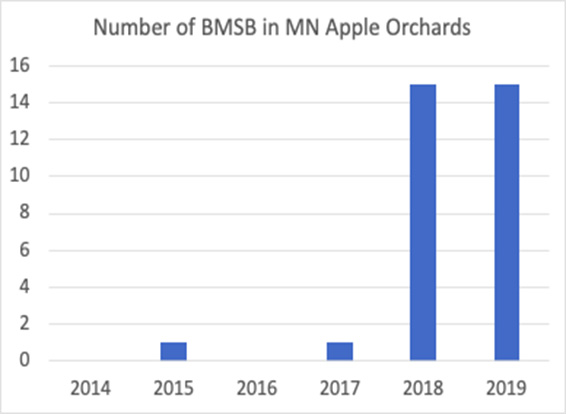
When do BMSB infest orchards?
In the mid-Atlantic region, BMSB have been found to infest orchards in the highest numbers in mid to late-August and September. Therefore, fruit harvested in September or later are exposed to the highest annual BMSB populations. However, because Minnesota is farther north, these high BMSB populations could occur slightly later in Minnesota orchards (September into October).
BMSB populations are not yet high enough in Minnesota agricultural areas to know the exact timing of their infestation into orchards, so more research is necessary to verify this. However, based on the MDA’s trapping data, all BMSB individuals caught in traps in orchards have been between 19 August and 11 October with the exception of 3 adults in 2019 caught on 6 June, 8 July and 15 July 2019, respectively.
BMSB Damage on Apples
BMSB feed on fruit using their piercing sucking mouthparts. Their feeding on apples in the late-season can result in depressions (with or without discoloration) (Fig. 2) and corky/scarred flesh immediately beneath the skin (Fig. 3). Depending on the severity of the feeding, the fruit can be rendered unmarketable.
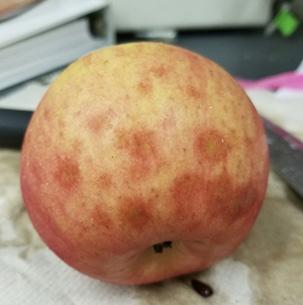
|
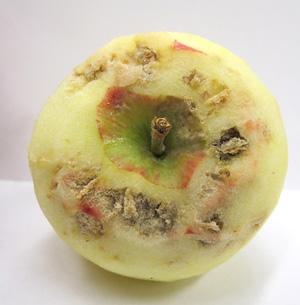
|
In Honeycrisp, and other apples that experience calcium-deficiency, BMSB damage can be confused with bitter pit. However, bitter pit causes sunken brown discolored spots externally (Fig. 4) and diffuse brown spots internally (Fig. 5), while external depressions from late-season stink bug damage exhibit more of a circular appearance and internally the corky tissue is more uniform and starts right at the apple skin.
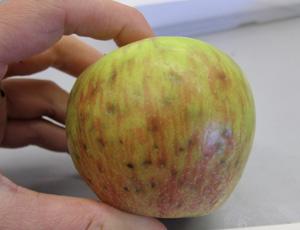
|
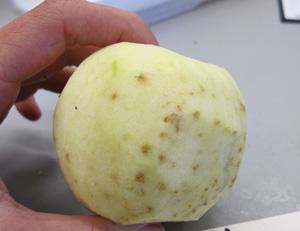
|
Recent Findings
Recent research findings from Hailey Shanovich (UMN graduate student), Eric Burkness (Researcher), and Dr. Bob Koch (Extension entomologist), have revealed that apple varieties are most susceptible to BMSB feeding and injury when they are 4 to 8 weeks away from harvest. They are less attractive to BMSB when they are within 4 weeks of harvest. It is counterintuitive, as we might expect a fully mature apple, that is highest in sugar, to be more susceptible. However, a slightly less mature apple may actually be more attractive to BMSB adults who may be looking for other nutrients such as starch; or more mature apples may emit volatiles that BMSB do not care for.
Early season varieties may be less susceptible to BMSB than mid- or late-season varieties. A study compared BMSB preference between Zestar!, Honeycrisp and Haralson apples at different timings throughout the late-season. Zestar! was found to have the least injury compared to the other varieties at all timings. Honeycrisp incurred the most injury from BMSB at all timings, except for when it was more mature than Haralson, at which point Haralson had more injury. Therefore, depending on the timing of BMSB infestation in Minnesota orchards, early-maturing varieties like Zestar!® may be safe from this window of susceptibility to BMSB. For example, if BMSB infest Minnesota orchards in mid-late August, early-maturing varieties would be 2 weeks or less from harvest and therefore not as susceptible as mid to late-season maturing varieties.
BMSB populations are not yet high enough in Minnesota agricultural areas to know the exact timing of their infestation into orchards, so more research is necessary to verify if all other early season Minnesota varieties, such as State Fair, SweeTango® and First Kiss® will also incur low levels of feeding from BMSB.
Scouting for BMSB in Orchards
Research from Mid-atlantic states has demonstrated that BMSB injury to apples at harvest tends to be greatest in fruit from the upper canopy of trees in border rows next to woods. Therefore, scouting efforts from August onward should be prioritized in these areas. In orchards and vineyards, beating limbs or vines over trays or cloth can help determine whether they are present. There are also commercial lures that can be paired with various traps to monitor for BMSB. Traps are best used between two habitats, like between a woodland and the orchard.
Researchers across the country have demonstrated that traps baited with a commercial lure containing the BMSB aggregation pheromone and a synergist (usually called “dual lures”) can be a very effective monitoring tool for BMSB, even when populations are low. The two main types of traps for stink bugs are pyramid traps and clear sticky traps, pictured below. The lures are hung on the traps to attract BMSB to them (see links under “More Resources” below for places to buy traps and lures for BMSB). However, pyramid traps require more assembly and can have issues with spiders building webs in openings.
Typically traps are placed at the orchard border and within the orchard. BMSB captured in these traps can be used to trigger a management action. The economic threshold for managing BMSB in apple is when 10 BMSB adults or nymphs have accumulated in an array of traps. However, if any BMSB are found in traps contact MDA's via their arrest the pest hotline. The MDA will also be continuing their BMSB monitoring in participating Minnesota orchards for 2020 so check their BMSB webpage and subscribe to their Plant Pest Insider Newsletter for updates.

|
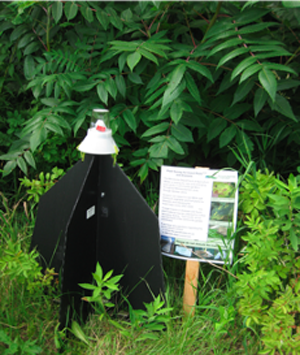
|
BMSB can be distinguished from other native stink bugs fairly easily (see the August 19, 2019 Fruit & Vegetable News BMSB article for identification information) or download and use the free Midwest Stink Bug Assistant app, created by the UMN Extension IPM Program.
BMSB Management for Orchards
Note that none of these control methods have been validated in Minnesota, as BMSB populations have not reached levels of economic concern in agricultural areas yet. These management recommendations are based on research from mid-Atlantic states.
Chemical Control (Organic and Conventional)
When 10 BMSB adults or nymphs have accumulated across all traps within the orchard or at the orchard border, management is warranted. A labeled organic or synthetic insecticide can be applied as two alternate-row-middle sprays with 7 days between applications. Interior traps will help determine if any follow up perimeter spray applications are needed every 7 days until harvest. This strategy has been shown to reduce the number of BMSB-targeted sprays needed while also maintaining good control of BMSB injury in the orchard. Insecticides should be rotated among products in different classes with different modes of action (see the MSU factsheet listed under “More Resources” for a list of all labeled synthetic insecticides, rates per acre and PHIs).
Some organic insecticides are labeled for the control of BMSB and other stink bugs in apple such as pyrethrin, potassium salts of fatty acids, azadirachtin and kaolin clay. Researchers from Maryland found that azadirachtin + potassium salts and pyrethrin offered 65-90% and 58-79% control of BMSB nymphs respectively, but offered relatively poor control of adults. Additionally, even though azadirachtin are labeled for use on apple, but not after the pink stage as it can result in phytotoxicity; tank mixing with oil-based products will also cause plant injury. Researchers at Virginia Tech found that kaolin clay provided significant control of both BMSB nymphs and adults in field trials.
Biological Control
Investigation of biological control for BMSB is ongoing. An egg parasitoid of BMSB eggs from its native range in Asia was recently detected in both the eastern and western U.S. This parasitoid shows high levels of BMSB egg parasitism in Asia and may have significant impacts on BMSB here in time. Additionally, various generalist predator insects, or natural enemies, will feed on BMSB eggs and nymphs and may provide important biological control services against this pest. Therefore, it is especially important to avoid any unnecessary insecticide applications.
Cultural Control
Research from Eastern states suggests that trap cropping may be a useful strategy, especially for organic producers, for managing BMSB. Recent research findings found that sunflowers and sorghum serve as effective trap crops for BMSB in those states. The trap crops are attractive to BMSB when they are moving to crops and can delay the colonization of the crop of concern and therefore reduce damage. Continued efforts are needed to identify appropriate trap crops for the Midwest as it is crucial to match the trap crop seasonality with the fruiting stage of apple.
Resources
- Managing Brown Marmorated Stink Bug in Michigan Orchards by MSU (updated July 2018)
- BMSB Orchard Crops factsheet by stopBMSB.org
- Brown Marmorated Stink Bug factsheet by MDA
- Stink Bug Management with Trap Crops on Organic Farms Webinar by UF
- BMSB traps and lures for sale: http://www.ecogreenwarehouse.com/insect-control/ or Great Lakes IPM sells Trece Stink Bug DUAL Lures 3718-05 and sticky traps but the lures are not listed on the website and need to be ordered over the phone at this time